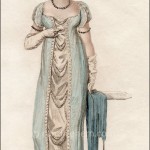Ackermann’s Repository of Arts, March 1812.
“Evening Full Dress.”
This is a pretty dress, very typical of 1812, but the most interesting thing here may be the footnote, explaining that the real dress is much more fashionable than represented by the artist!
In the first year of this publication, many of the dresses represented in the prints, as well as most of the fashion commentary, were provided by the famous modiste, Madame Lanchester. The designer of this dress was Mrs. Gill, who is believed to have once apprenticed to Madame Lanchester. The effusive comments here about Mrs. Gill suggest that her mentor may still have been penning some of the fashion commentary and description. And it would be in keeping with Madame Lanchester’s vanity to chastise the artist!
The print is described in the magazine as follows:
“A round robe of white imperial crape, or gossamer net, worn over white satin; short Spanish pointed sleeves, caught up in the center of the arm with pearls or white beads; wide stomacher of the same, finished with pendant drops on each side; a narrow vandyke trimming at the edge of the bosom in the front; the back and shoulders finished with a row of white beads. A Circassian turban of gold spotted muslin or tissue, embellished on the left side with bows and ends of white ribbon. Hair divided irregularly on the forehead, and in curls on each side. Necklace and earring of brilliants, or two rows of pearl, with a drop in the center; bracelets en suite. White satin slippers, with gold buttons or clasp. French kid gloves, below the elbow. Fan of carved ivory or gold-spangled crape. A small bouquet placed entirely at the left of the bosom.
“We need scarcely inform our readers that these very elegant habiliments are furnished entirely by Mrs. Gill, of Cork-street. The distinguishing taste and unique invention of that lady (both as of elegance of style, and judgment in adaptation), we may, without detracting from the merit of the many, pronounce as superior to most, and inferior to none!”
At the bottom of the page where the print is described is the following interesting footnote:
“* The full dress in this number is not at all a fair specimen of haut ton; it should be very much lower, and more square in the front, and the sleeves much smaller; indeed, a mere strap, so that the whole of the bust, shoulders, and arms may be completely exposed: we could not overcome the modest objections of the artist, to representing the figure in the extreme of fashion.”








